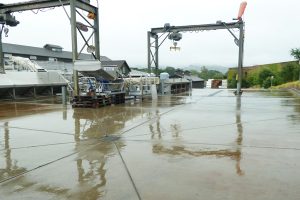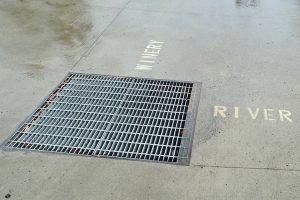KJ continues its support of California wineries by providing insights into the regulations that impact their operations. California’s State Water Resources Control Board (SWRCB) adopted the latest version of the General Permit for Storm Water Discharges Associated with Industrial Activities (IGP) in April 2014 (2014 IGP). Because this is the first revision to the IGP in nearly 20 years, there are significant changes compared to the previous version of the IGP.
One of the more significant revisions for the wine industry is the elimination of the “light industry exemption.” Under the previous IGP, many wineries qualified for this exemption. Because the updated IGP no longer includes this exemption, most wineries in California need to take action.
The revised IGP applies to wineries (standard industrial code of 2084) that are conducting onsite industrial activities (e.g. winemaking and associated activities) and have offsite discharges of stormwater (also known as “stormwater” in California). To assess the level of permit compliance, a winery needs to determine which of the four types of filings applies to their facility:
1. No Exposure Certification (NEC)
Applicable if stormwater discharging from the site never has an opportunity to come in contact with industrial pollutants because all industrial activities are undercover.
2. Notice of Non Applicability (NONA)
The IGP does not apply to a winery if the facility is constructed to have no discharge offsite or is not hydraulically connected to waters of the US (the latter is hard to confirm – need to use Army Corps of Engineers maps which are currently being developed).
3. Notice of Termination (NOT)
If a winery was currently covered under the 1997 IGP but industrial activities have been discontinued or there has been a change in ownership at the winery, a Notice of Termination should be filed.
4. Notice of Intent (NOI)
A winery is subject to the 2014 IGP if stormwater will come into contact with industrial activities, equipment, or materials and then a discharge leaves the site. Wineries that had permit coverage under the 1997 IGP need to “recertify” their Notice of Intent (NOI) through SMARTS; submit permit registration documents (PRDs); and develop and submit a stormwater pollution prevention plan (SWPPP) and site map. Facilities that are new to the IGP (likely because they previously qualified for the light industry exemption) need to file a NOI to comply; submit PRDs; and develop and submit a SWPPP and site map.
A summary of Important Changes to the 2014 IGP
Click HERE for a summary of important changes to the 2014 IGP.
KJ has also prepared a Fact Sheet for the new IGP. Download it for a full summary of the new IGP. Click 2014 ISP Fact Sheet to download.
Next Steps for Wineries in California
Wineries should evaluate the opportunity to implement structural improvements that will allow the facility to qualify for a NEC or for a NONA. Where filling a NEC enrolls a winery in the 2014 IGP, it represents a lower regulatory burden than filing an NOI and implementing a SWPPP. Wineries that are considering a NEC need to consider issues such as:
- According to the SWRCB, the transportation of open bins of grapes across internal roadways is an industrial activity. Even if all other industrial activities are under cover, the act of bringing an open bin of grapes onto the facility may negate the ability to qualify for a NEC. However, there are potential best management practices (BMPs) to address this issue
- The loading/unloading juice or wine from tanker trucks which require specific structural improvements to qualify for a NEC.
A NONA allows a winery to get out of the permit by containing stormwater onsite. However, determining if a winery meets the requirements for a NONA can be difficult. Some facilities discharge stormwater from the industrial facility onto their own vineyards and hydraulic calculations may be needed to determine if that stormwater can reach property boundaries. These calculations may show that simple structural improvements (e.g., berms) may allow a facility to qualify for a NONA. Also, sometimes the Wastewater Discharge Requirement (WDR) permit addresses stormwater. Because the same activity (i.e., stormwater) cannot be covered by two permits, the IGP may not be applicable. It is recommended that winery personnel read through their WDR permit carefully and review the Report of Waste Discharge that was originally submitted when applying for the WDR permit.
For those facilities that are subject to the IGP and are required to develop a SWPPP and site plan, the winery should be sure to distinguish the “Facility” from the rest of the property. The “Facility” is where industrial activities take place and should not include vineyards, vineyard shops, or tasting room. The Facility will include all the industrial activities beginning with the grape weigh station (e.g., scale) and ending with case goods leaving the warehouse dock. Parking areas are not part of the industrial facility, unless open grape bins or gondolas pass through the parking area or if industrial activities, such as filling barrels, take place in the parking lot areas. Other issues wineries should consider as part of their stormwater management programs include:
- The connection between the onsite process water and stormwater drainage systems. Some of the BMPs pertaining to management of wastewater during harvest season change as soon as the harvesting and grape processing activities are finished.
- The transportation of open bins of grapes across internal roadways will need to be addressed in the SWPPP.
- The loading/unloading juice or wine from tanker trucks will need to be addressed in the SWPPP.
- The generation/storage/loading/transportation of pomace, diatomaceous earth, and lees will need to be addressed in the SWPPP.
Furthermore, communication by the SWRCB to the many wineries across the state has been limited. There are many facilities that are unaware of the change in this permit and that there is a need for those facilities to address whether or not they require coverage. Management and enforcement of the IGP is left to the nine Regional Water Quality Control Boards. And, because the IGP language is vague and subject to interpretation, it is important for a winery to understand the perspective and expectation of the Regional Water Quality Control Board with jurisdiction over its facility.
For More Information
More information, including the permit, is available on the SWRCB’s website: http://www.swrcb.ca.gov/water_issues/programs/stormwater/industrial.shtml
For our wine environmental questions, go directly to our experts: BobChrobak@KenndyJenks.com, KatieMcCoy@KennedyJenks.com, or SusanneZechiel@KennedyJenks.com.
If you are interested in more information on Kennedy Jenks, don’t forget to subscribe to our blog!



